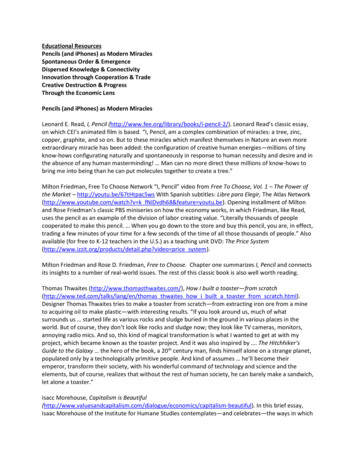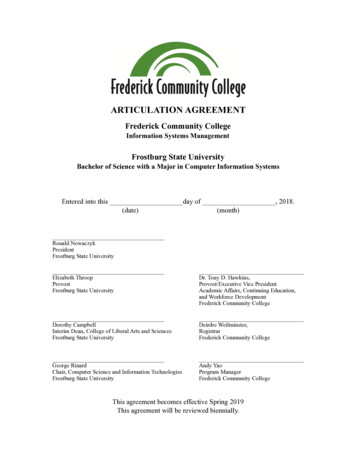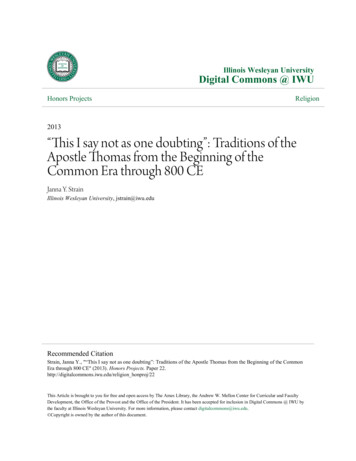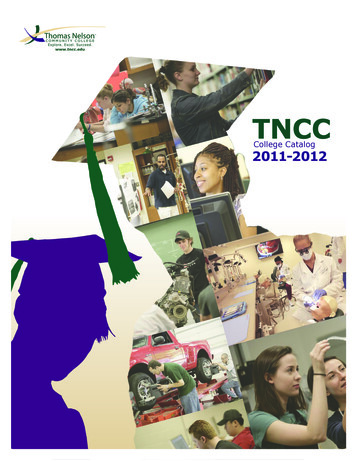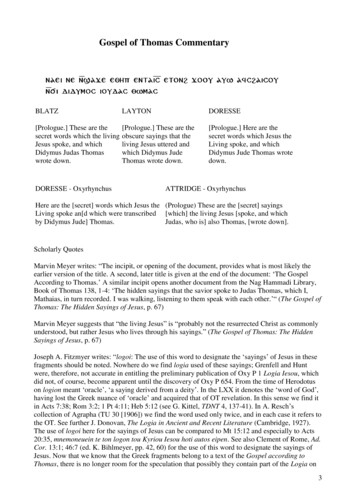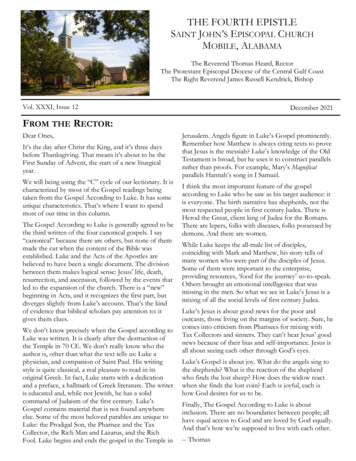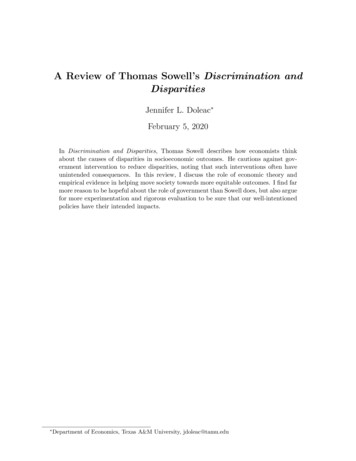
Transcription
A Review of Thomas Sowell’s Discrimination andDisparitiesJennifer L. Doleac February 5, 2020In Discrimination and Disparities, Thomas Sowell describes how economists thinkabout the causes of disparities in socioeconomic outcomes. He cautions against government intervention to reduce disparities, noting that such interventions often haveunintended consequences. In this review, I discuss the role of economic theory andempirical evidence in helping move society towards more equitable outcomes. I find farmore reason to be hopeful about the role of government than Sowell does, but also arguefor more experimentation and rigorous evaluation to be sure that our well-intentionedpolicies have their intended impacts. Department of Economics, Texas A&M University, jdoleac@tamu.edu
1IntroductionThomas Sowell’s book, Discrimination and Disparities, considers the source of disparitiesin economic outcomes, and the role of government in addressing them. His first point is thatnot all disparities are due to discrimination — a point well-supported by economic theoryand evidence but often a source of confusion in public conversations. He goes on to provideexamples of how mis-attributing disparities to discrimination leads to misguided governmentinterventions that actually make things worse, increasing disparities where they’d intendedto shrink them. His conclusion is, essentially, that we should stop trying to intervene inmarkets we don’t fully understand, and allow the invisible hand of market forces to reducedisparities to efficient levels in the long run.Most economists would agree with Sowell on his definitions of discrimination and potential unintended consequences of government intervention. But many — including me —will disagree with him about the current state of evidence and his policy takeaways. Myinterpretation of existing evidence is that government intervention can move us closer to oursocietal goals and make markets work more efficiently. But the possibility of unintendedconsequences is real and should push us to (1) consider what is causing the disparities wewant to address, (2) design interventions that target those underlying causes, and (3) rigorously evaluate the policies we implement, to make sure they are having the net benefits we’dhoped for.2Discrimination and Disparities: DefinitionsSowell defines three types of discrimination that can lead to disparities in outcomes. (Hefocuses primarily on discrimination and disparities related to race. I will mostly do the same,though everything here can be applied to disparities related to gender, age, socioeconomicstatus, and so on.) In Sowell’s framework, Discrimination 1a is sorting individuals accuratelybased on relevant characteristics. That is, decisions are made based on qualifications such aseducation or work history. Racial disparities in economic outcomes are thus driven by racial1
disparities in those observable characteristics. (Economists typically would not call this‘discrimination.’ However, disparities arising from such decisions have what lawyers wouldrefer to as a ‘disparate impact’ on disadvantaged groups, and this can be used as evidenceof discrimination in legal settings.) Discrimination 1b is sorting individuals based on groupaverages; this is what economists call ‘statistical discrimination.’ This type of discriminationis used when gathering enough information on an individual’s relevant characteristics –to rely on Discrimination 1a instead – is more costly or even impossible. An observablecharacteristic such as race might then be used as a proxy for unobservable characteristicsof interest (such as productivity) if they are statistically correlated. Finally, Discrimination2 is what economists refer to as ‘taste-based discrimination’ or ‘animus.’ It occurs whendecision-makers care about race itself, not race as a proxy for something else. Economiststypically model this as a cost incurred by the decision-maker when they interact with aperson of color: they derive negative utility from such an interaction.How much do each of these types of discrimination matter? This is an important butdifficult question to answer. Sowell questions the existence of racial disparities in the firstplace, blaming misleading statistics for making us think reported disparities are bigger thanthey actually are. For instance, he notes that omitting non-workers from studies of earningscan bias estimates of racial disparities. This is a legitimate concern, though we’d probablyexpect the bias to go in the other direction. Indeed, recent work using data that includesthe zero-earnings observations from non-workers shows that racial disparities in earnings arein fact larger than they’d previously appeared, and have widened since 1970 (Bayer andCharles, 2018). My view is that it is undeniable that large racial disparities in economicoutcomes exist; I will not devote more space to this issue.A more interesting question is what drives these disparities. Several times, Sowell compares the uneven distribution of favorable outcomes in the population to the uneven distribution of phenomena like tornadoes — implying that the status quo may simply reflectthe natural order of things. He begins the book with a lengthy discussion of how success2
typically requires many prerequisites (e.g. intelligence, effort, living in a place with goodinstitutions), and the absence of any one can mean failure. This, he claims, means it shouldnot be surprising that success is not evenly distributed. Even if the underlying prerequisitesare randomly distributed, the distribution of who is successful will be highly skewed, withonly a small share of people having all the prerequisites necessary for success.What Sowell does not discuss is that random distribution of the prerequisites would notproduce outcomes that are correlated with traits such as race. The fact that black residentsof the U.S. suffer far worse outcomes than white residents implies that the probabilities thatthese various prerequisites are satisfied vary by race. Some have argued that this is due todifferences in genetic makeup; to his credit, Sowell does not make this argument, and in factseeks to provide an alternative explanation. But if outcomes are correlated with race thenthis necessarily implies that underlying opportunities or circumstances must be distributedin a way that is correlated with race. Sowell argues that this is not necessarily due to malice,and that is certainly true. But such outcomes also cannot simply be due to chance.This position – that racial disparities are due to random chance – is odd in part becauseit seems to blatantly ignore societal realities, and also because it does not seem necessary forthe arguments that follow. While noting repeatedly that he is not ruling out Discrimination1b and 2, Sowell spends much of the book arguing that most existing disparities are due toDiscrimination 1a — that is, accurate sorting of applicants by employers, banks, and so on.Disparities based on accurate sorting on traits like educational attainment can be due tounequal opportunity — say, less access to good schools as a child. Differences in opportunityare not an employer’s fault or responsibility, but are also not natural phenomena. Theyshould direct us to address those childhood disparities as the way to reduce adult disparities.Ignoring this implication serves only to deny our power to change the status quo.I also found it strange and misleading that Sowell does not engage at all with the large andever-growing economic literature on whether people are treated differently due to their race.There is plenty of rigorous evidence that Discrimination 1b and 2 (statistical discrimination3
and animus) exist and are pervasive.1 So, we know that disparities are not solely due toDiscrimination 1a (discerning real differences between people), though quantifying the overallcontribution of each type of bias is still difficult.Nonetheless, I appreciate Sowell’s thorough and accessible discussion of how economiststhink about discrimination and disparities (distinguishing Discrimination 1a from 1b and 2);this is by far the strongest aspect of the book. And I agree with him that it is importantto distinguish between these different reasons for disparities across groups. Understandingthe cause of racial disparities in hiring, for instance, is key for designing policies that canshrink those disparities. I’ll provide examples of this below. However, I found Sowell’s lack ofengagement with current theory and empirical evidence – including on the ability of marketsto eliminate discrimination – disappointing and unproductive.3Why Doesn’t Market Competition Eliminate Discrimination?It is worth considering how and why discrimination persists in competitive markets. Manyare familiar with Becker’s model of taste-based discrimination (Becker, 1957). This classicmodel predicts that as long as there are a sufficient number of unbiased employers, they willtake advantage of biased employers’ prejudice and hire black workers at lower wages, thusincreasing their profits. Over time, these unbiased employers will drive biased employers outof business, eliminating the racial gap in pay. So, how do we find ourselves in a world wherediscrimination exists?Economists have considered this question over several decades, demonstrating that variations on Becker’s model can produce persistent racial disparities in wages and employment(see Charles and Guryan, 2011, and Lang and Lehmann, 2012, for reviews). For instance,statistical discrimination against black workers in the labor market – what Sowell refers to1For reviews see Charles and Guryan (2011), Lang and Lehmann (2012), Guryan and Charles (2013),Bertrand and Duflo (2017), and Neumark (2018), among others. Of course there are caveats and manyunanswered questions. See Heckman and Siegelman (1993) and Heckman (1998) for critiques of audit studiesthat remain relevant; Neumark and Rich (2019) for a reexamination of a subset of field experiments; andCharles and Guryan (2011) for a discussion of various open questions related to the presence and mechanicsof discrimination.4
as Discrimination 1b – can lead black youth and young adults to invest less in human capitalthat is not perfectly observable by employers. Intuitively, if individuals will be compensatedprimarily based on their group’s average (instead of their own skill level), they will haveless incentive to attain better-than-average skills. (This is fundamentally a shift from amodel with perfect information to a more realistic one where worker quality is not perfectlyobservable by employers; see Lundberg and Startz, 1983, and Coate and Loury, 1993.)Adding search costs to models of the hiring process can also produce persistent disparitiesin employment and wages. If even a few biased employers exist, and it is costly to searchfor better opportunities, then black job-seekers will have lower reservation wages, leadingthem to accept lower offers. This in turn incentivizes unbiased employers to offer black jobcandidates lower wages as well, leading to racial disparities in equilibrium. See Lang andLehmann (2012) for a full discussion.Acknowledging the relevance of social networks also leads to important insights (Loury,1998). Even small amounts of discrimination can result in racial segregation of housingand employment, with corresponding effects on networks. Individuals whose networks arerelatively disadvantaged can be thought of as having less social capital (an important formof human capital); they will find it difficult to improve their economic outcomes. In a worldwhere one’s peers affect social norms (which can shape individual preferences), access toresources like credit (for human capital investment), and information about job openings,even discrimination against members of previous generations can lead to worse outcomes forindividuals today. This also means that the choices of any individual have externalities – theyaffect others in that person’s network. This will generally lead to suboptimal investments inhuman capital, as the individual does not consider the external benefits of such investmentwhen making decisions.Because segregated networks limit social interactions between members of different groups,they can also slow the rate at which employers update inaccurate group stereotypes aboutworker productivity (see Arrow, 1998, for a discussion). Bordalo et al. (2016) proposes an5
economic model of inaccurate stereotypes, showing that common cognitive biases lead to systematic mistakes in how humans recall population distributions, in a way that exaggeratestrue differences across groups. This could lead people to overestimate the likelihood thata young black man has a criminal record, for instance, based on the “kernel of truth” thatyoung black men are more likely than members of other groups to have criminal records.Statistical discrimination based on such inaccurate stereotypes could further reduce disadvantaged groups’ investment in their human capital, because they reduce the payoff to suchinvestment.One need look only as far as the economics profession for examples of such market failures.Economics has long faced gender and racial disparities at various points in the academicpipeline – from the composition of college majors and new Ph.D.s to the composition offull professors, particularly in higher-ranked institutions (Lundberg, 2019; CSMGEP, 2019).There are at least two reasons that these disparities are concerning: (1) current practices areleading to inefficient outcomes (discussed in more detail below), and (2) the current lack ofdiversity limits the quality of ideas produced by the profession, due to existing economists’limited personal experiences relevant to important research and policy questions.As in other contexts, it is not obvious a priori that existing disparities are due to discrimination within the economics profession – they might be due to pre-existing differencesin training or broader social norms that shape career preferences. However, there is rapidlyaccumulating evidence that current norms and practices in the economics profession resultin biased treatment of women and other underrepresented groups (Lundberg and Stearns,2019). It is straightforward to see how these biases can contribute to persistent and inefficientdisparities that market forces alone will not shrink.As described above, high search costs in the academic job market imply that even a fewbiased employers can cause persistent disparities in employment and pay, even if there areno disparities in publication or other observable output. But it appears that such disparitiesin output do exist, even when underlying productivity is the same. Several studies show6
that women are held to a higher standard in academic publishing. Papers by female authorsin top journals are cited more often than similar papers by men, suggesting that they aremore meaningful contributions to their literatures (Grossbard, Yilmazer and Zhang, 2018;Hengel and Moon, 2020; Card et al., 2020). It appears that referees and editors push femaleauthors to write more clearly than male authors in order to convey and defend their ideas –consistent with their being less likely to give female authors the benefit of the doubt whenwriting is unclear (Hengel, 2020). This gender gap in writing quality widens over individuals’careers, suggesting that women rationally respond by spending more time investing in thisskill (an investment that men do not need to make). This also lengthens the time it takes topublish each paper, which could reduce the likelihood of tenure for women on the margin.Even after papers are published, women may not get equal credit for their work. Sarsons(2017) finds that while sole-authored work increases the likelihood of tenure and promotionequally for men and women, coauthored work benefits men more than women (that is,women systematically get less credit for coauthored work, particularly when the work iscoauthored with men). Student evaluations of teaching are often considered when settingpay and determining promotion, and there is now extensive evidence that such evaluations arebiased against female professors (MacNeil, Driscoll and Hunt, 2015; Boring, 2017; Mitchelland Martin, 2018; Mengel, Sauermann and Zölitz, 2019). Recent work has also shown thatwomen are more likely to be tapped for low-promotability tasks (think departmental service)than men are (Babcock et al., 2017; Babcock, Recalde and Vesterlund, 2017).If we consider two equally productive junior faculty, one male and one female, the researchdescribed above suggests that the woman will likely publish fewer articles and in lowerranked journals, get less credit (e.g. from colleagues and letter-writers) for the work she doespublish, get lower teaching evaluations, and spend more time doing departmental service andother low-promotability tasks (which in turn will likely slow her research output further).This all means she will be less likely to garner outside offers or be promoted within herown institution. Even if her department chair and colleagues are not biased themselves,7
biases in the publication and evaluation processes mean it would be rational to statisticallydiscriminate against women in hiring and wage decisions because, on average, women willappear less productive and have fewer outside options. This could lead rational femalestudents not to pursue a Ph.D. in economics or career in academia in the first place, or toinvest less in their research agenda even if they stay on the tenure track.Finally, there is evidence that women and racial minorities have weaker and more segregated networks that hinder mentoring, research collaborations, and research dissemination(McDowell, Singell and Stater, 2006; Ductor, Goyal and Prummer, 2018; Romer and Wolfers,2018; Doleac and Pancotti, 2020). Segregated networks within the profession make it difficultfor members of these groups to get seminar and conference invitations that would increasetheir social capital (including access to potential mentors, collaborators, and referees), provide feedback on their work, and give them access to job opportunities (particularly in theadvanced assistant and senior academic markets, where hiring depends heavily on word-ofmouth and personal knowledge of whether potential candidates are ‘moveable’). Segregatednetworks also allow negative stereotypes to develop and persist (e.g. that women are alwaysthe trailing spouse, or that childcare responsibilities make them unwilling to travel for work),resulting in further statistical discrimination based on these inaccurate beliefs and, in turn,even less up-front investment by the groups that are the subject of these stereotypes.If discrimination can persist in the economics profession – where we are trained to noticeand address market failures like these – it is not surprising that it can persist in othercontexts. The question now is what to do about it.22The evidence on what works to reduce disparities in this and similar contexts is thinner but also increasing(Boring and Philippe, 2017; Romer and Wolfers, 2018; Flory et al., 2018; Boustan and Langan, 2019;Buckles, 2019; Porter and Serra, 2019). Rigorous evaluation of future interventions will be crucial since wellintentioned policies in this area can easily have unintended consequences. Examples of interventions thathave been shown to unintentionally reduce diversity in the application and hiring process include simple equalopportunity statements in job postings (Leibbrandt and List, 2018), and making job applications anonymous(Behaghel, Crépon and Le Barbanchon, 2015). And interventions such as gender-neutral parental leave –which aimed to reduce gender disparities in promotion by reducing female academics’ burden of childcare –unintentionally reduced tenure rates for women in economics while increasing tenure rates for men (Antecol,Bedard and Stearns, 2018).8
4Why Discrimination Type Matters: The Case of ‘Ban the Box’A policy example that Sowell highlights is one I spend a lot of time thinking about:Low employment rates for people with criminal records, and efforts to increase employmentfor this group. A primary motivation for policy efforts in this space is to reduce racialdisparities in employment. Given large racial disparities in who has a criminal record in theUnited States, low employment rates for this group disproportionately harm people of color,particularly black men.Why don’t employers hire people with criminal records? It could just be that, on average,those with records are less qualified for the job — maybe they have less education or workexperience. These reasons would be examples of Discrimination 1a in Sowell’s framework.Low labor force attachment rates for people even before their first conviction or incarceration (Mueller-Smith, 2015; Looney and Turner, 2018) suggest that Discrimination 1a is animportant factor in this discussion.But we know that people with criminal records are less likely to get callbacks fromemployers even when all other observable information is held constant (Pager, 2003; Aganand Starr, 2018). This may contribute to recidivism and other social ills, with resulting socialcosts that are not internalized by employers. Such negative externalities lead to inefficientoutcomes that justify government intervention. The key question for those trying to designeffective policies is why employers are discriminating against applicants with criminal recordsin the first place. Is it that employers view a criminal record as a negative signal aboutother characteristics they care about but cannot observe – traits like honesty, reliability,interpersonal skills, or the likelihood of committing a crime on the job? If a criminal recordis correlated with these underlying traits, then this would be Discrimination 1b in Sowell’sframework — ‘statistical discrimination’ in common economic parlance. If employers simplydo not want to associate with people who have broken the law, and there is nothing youcould tell them about the person in question that would change their mind — that is,they care about the criminal record itself, not as a proxy for something else — then this9
is Discrimination 2 in Sowell’s framework, and ‘taste-based discrimination’ or ‘animus’ ineconomic terms.We don’t yet fully understand why employers discriminate against people with criminalrecords — this is one of many relevant questions on the research frontier. But the reasonsare important because they have different policy implications. If employers are statisticallydiscriminating against people with records, and don’t actually care about the records themselves (Discrimination 1b), then we can reduce the disparities by providing more informationabout the applicant’s underlying traits (honesty, productivity, and so on), or by reducing thecorrelation between having a criminal record and having the negative traits that employersworry about (by investing in rehabilitation). If employers’ discrimination against people withrecords is due to simple animus, then we’ll need to increase the cost of such discrimination(by making it illegal, for instance, or providing financial incentives to hire people from thisgroup), until the perceived cost of hiring the person is equal to the perceived benefit.And to the extent that broader disparities in employment for people with and withoutrecords are driven by disparities in their true work-readiness (Discrimination 1a), we’ll needto invest in education and programs that make them more productive.Policies that target one source of disparity when another was at work can be ineffectiveat best, and have important unintended consequences at worst. For instance, Ban the Box(BTB) policies prohibit employers from asking a job applicant about their criminal recorduntil late in the hiring process. Employers can still run a background check before hiring theperson, but then are often required to justify a decision not to hire that applicant if theircriminal record is worrisome. The goals are (1) to allow more people with records to get theirfoot in the door, possibly allowing them to build rapport with and signal their work-readinessto an employer during an interview, and (2) to increase the costs associated with not hiringsomeone because of their criminal record. That is, the policy is targeting Discrimination1b (with additional information conveyed during an interview) and Discrimination 2 (withincreased costs of not hiring someone with a record once a background check is conducted).10
This policy’s effects will depend on what drives the disparities it aims to address. Ifemployers’ reluctance to hire people with records is due to Discrimination 1a (for instance,low education) then BTB won’t have any effect on outcomes — the same people will be sortedout during the hiring process as before. If their reluctance was due to Discrimination 1b (andan interview does not reveal the information of interest to the employer) or Discrimination 2(animus), then BTB can have unintended consequences. In these cases, BTB does not changeemployers’ concerns about hiring someone with a criminal record, but (by design) now makesit more costly to differentiate between otherwise-similar applicants with and without records.After BTB, employers need to go through the full interview process with an applicant, andmake a conditional job offer, before they can ascertain whether the applicant has a criminalrecord that the employer perceives as disqualifying. At that stage, if they decide not to hirean applicant because of his record, they risk legal scrutiny of that decision.Once threatened with these additional costs, employers may simply try to guess whichapplicants have a recent criminal conviction that would concern them, and avoid even interviewing those people. Though they can no longer see that information up front, they maytry to infer it from the remaining characteristics they can see — such as age, sex, race, andeducation. They would then statistically discriminate against groups that are more likely tohave a recent conviction, such as young men of color who don’t have a college degree. InSowell’s terms, they may engage in Discrimination 1b against applicants from this group —a much larger group than suffered from discrimination before. This harms young, low-skilledblack and Hispanic men who don’t have a criminal record. They were able to easily signaltheir clean record to employers before BTB, but now cannot. This reduces their rate ofcallbacks and employment.Sowell cites research showing that employers’ access to criminal records was associatedwith increased hiring of black men (Holzer, Raphael and Stoll, 2006); this suggests that statistical discrimination based on race is used in the absence of criminal record information.More recent research shows that – as economic theory predicts – BTB made this problem11
worse: when employers cannot ask about criminal records, they increase statistical discrimination based on race, and net employment of young, low-skilled, black men falls (Agan andStarr, 2018; Doleac and Hansen, 2018). Other recent research shows that BTB is not helping people with records get jobs (see for example, Rose, 2017, and Jackson and Zhao, 2017),likely because the policy does not address the reasons for employers’ initial reluctance to hirepeople from this group.3 (These candidates can still be rejected when their criminal recordis checked at the end of the hiring process.) Two studies find that BTB increases crime andrecidivism among black and Hispanic men, presumably because the policy makes it moredifficult for them to find work (Sabia et al., 2019; Sherrard, 2020). There is also evidencethat BTB incentivizes some applicants without records to get an occupational license that isoff-limits to people with certain convictions, as a way to “buy back the box” that legislatorsbanned (Blair and Chung, 2018; Marchingiglio, 2019). These findings highlight the complexinteractions of information within labor markets, and how important it is to consider thelikely behavioral responses to any policy change.The effects of BTB highlight important problems with how our legal system currentlytries to reduce discrimination. Courts often consider evidence of a ‘disparate impact’ on disadvantaged groups to be sufficient to ban the use of particular information (such as criminalrecords) in the hiring process. But the statistical correlation that produced the disparateimpact (for instance, on black men) is exactly what leads to unintended consequences whenthat information is removed (in this case, statistical discrimination against black men). Thismeans that the current disparate impact standard used in courts could do more harm thangood: banning the use of information based on its disparate impact on a particular groupmay effectively broaden the discrimination to that entire group.3Two additional studies claim to find that BTB had beneficial effects for targeted groups, but datalimitations make their estimates difficult to interpret (Shoag and Veuger, 2016; Craigie, 2020). For morecomplete reviews of this literature, see Agan and Doleac (2017), Doleac (2019b), Doleac (2019c), and Doleac(2019a).12
5Can Policy Interventions Reduce Disparities?BTB provides a clear example of one of Sowell’s main points: Unintended consequencesof government interventions are a real concern. And while unintended consequences arecommon, there are even more public policies that simply do not have their intended benefits.But Sowell is much more pessimistic than I am about the power of government to do good.Indeed, he focuses on the lack of market incentive for governments to be effective — thereis no competing firm that will take a government bureaucrat’s job if his program fails, andpolitical incentives often prevent policymakers from
Thomas Sowell's book, Discrimination and Disparities, considers the source of disparities in economic outcomes, and the role of government in addressing them. His rst point is that not all disparities are due to discrimination a point well-supported by economic theory and evidence but often a source of confusion in public conversations.


